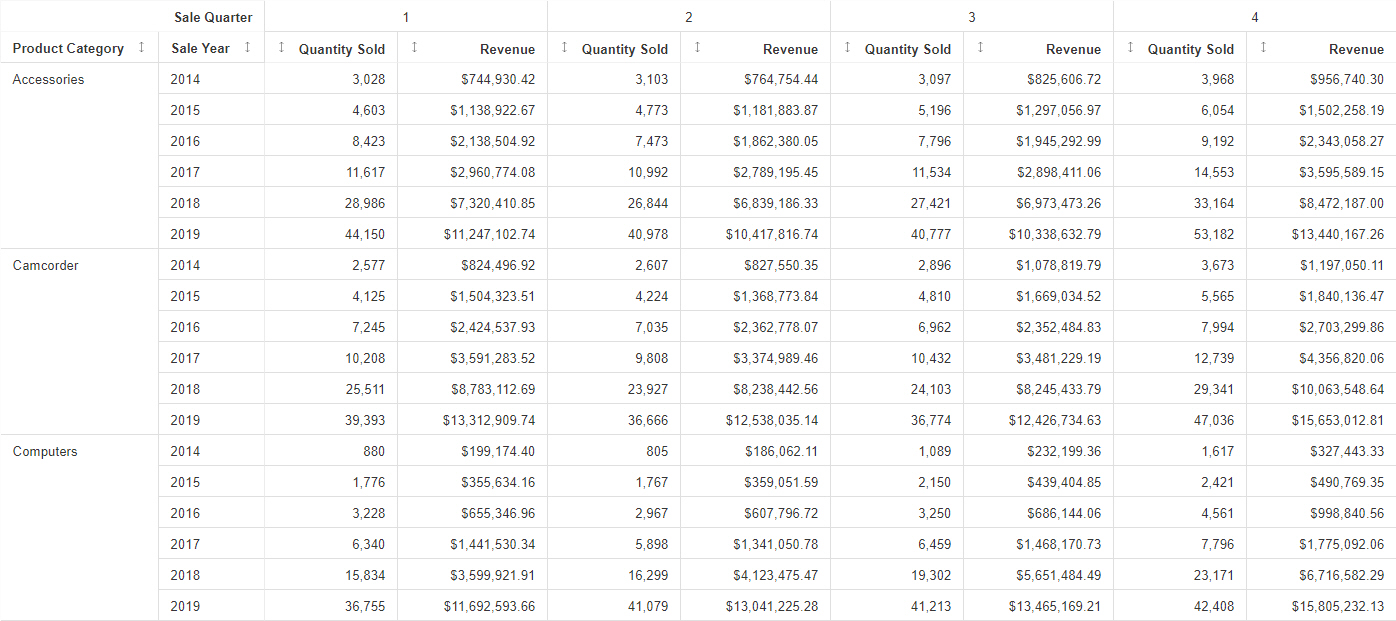Creating Data Grid Charts
A data grid is a kind of chart that can be used to present data in tabular form. For example, you can create a grid (table) that summarizes your data. Data grids include sorting and tooltip features by default, unlike tabular reports. An example of a data grid is shown in the following image.

Note: Data grids require at least one measure and one dimension. Additional measures create unique columns. You can add multiple dimensions in the Row bucket to create customized rows based on the structure of your selection, and add dimensions to the Column bucket to create groups of measure columns based on dimension values.
The following display options are available for a data grid:
- Calculation options:
- Summaries. Sums measure values for each sort value. This is the default.
- Counts. Provides a count of records in the selected measure field, for each sort value.
- Details. Displays the value of each individual record.
- Clear buckets content. Empties all buckets.
You can add fields to the following buckets for a data grid:
- Measure. Supplies the measure values to display in the cells of the data grid.
- Row. Use a dimension field to define the rows in the data grid, similar to the BY field in a report.
- Column. Use a dimension to provide an additional sort column for each value. Each measure column is nested within each column field value. The column bucket is similar to an ACROSS field in a report.
- Animate. Enables you to animate time progression using a slider control. As you move the control along the slider bar, an animation effect results. The slider control has a Play button that allows you to play and pause the animation. When you click Play, the Pause option is activated, enabling you to pause the progression and analyze your data. Slider controls are limited to one sort field and should be time or sequence related, such as month or year.
- MultiPage. Enables the creation of multiple graphs based on the field that you place in this bucket. The MultiPage bucket is available for stand-alone charts. If you convert the chart to a page created from new content, the MultiPage bucket disappears.
Procedure: How to Create a Data Grid
- Open WebFOCUS Designer. On the WebFOCUS start page, click the plus menu and then click Create Visualizations, or, on the WebFOCUS Home Page, click Visualize Data.
WebFOCUS Designer opens in a new browser tab.
- Select a workspace and a data source available from that workspace.
Once you select a data source, WebFOCUS Designer loads with options to create a single content item.
- On the Content picker, select Data Grid (Chart).
- Add one or more measures and dimensions to the chart.
The data grid refreshes with your selections.
- You can perform the following tasks with your data grid:
- Add additional measures or dimensions to the chart, where applicable.
- Change the fields to obtain different information.
- Format the chart (for example, customize the header and footer or style the legend).
- Save your data grid.
- Release: 8207
- Category: Visualizing Data
- Product: WebFOCUS Designer
- Tags: How-to's
